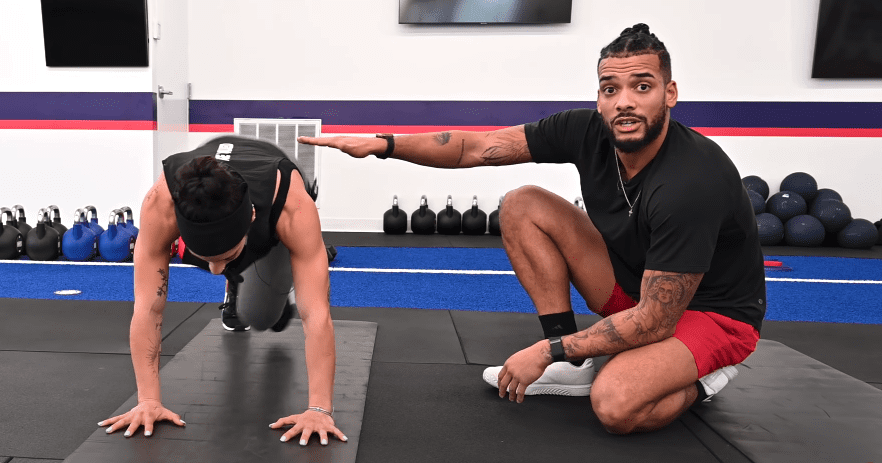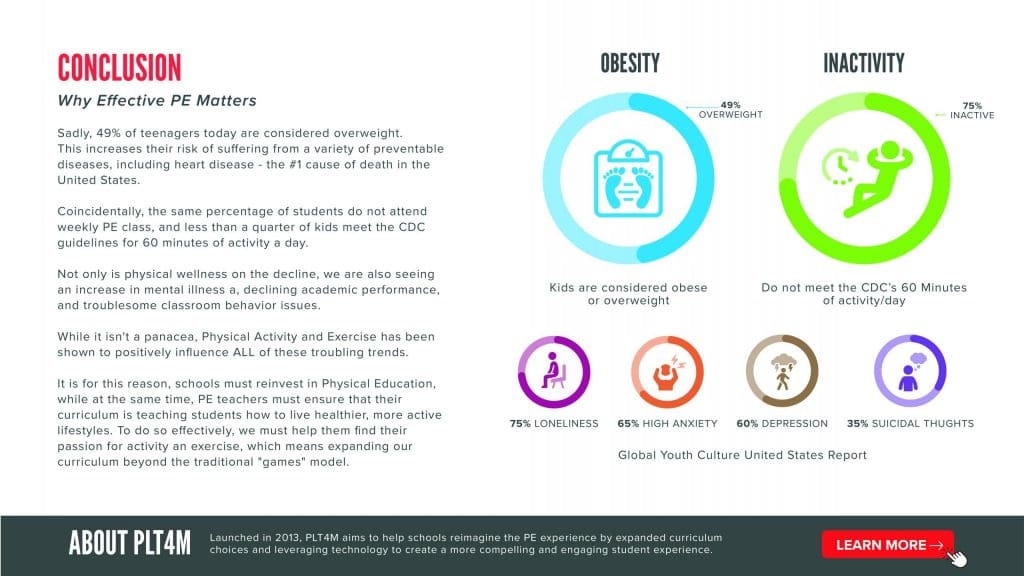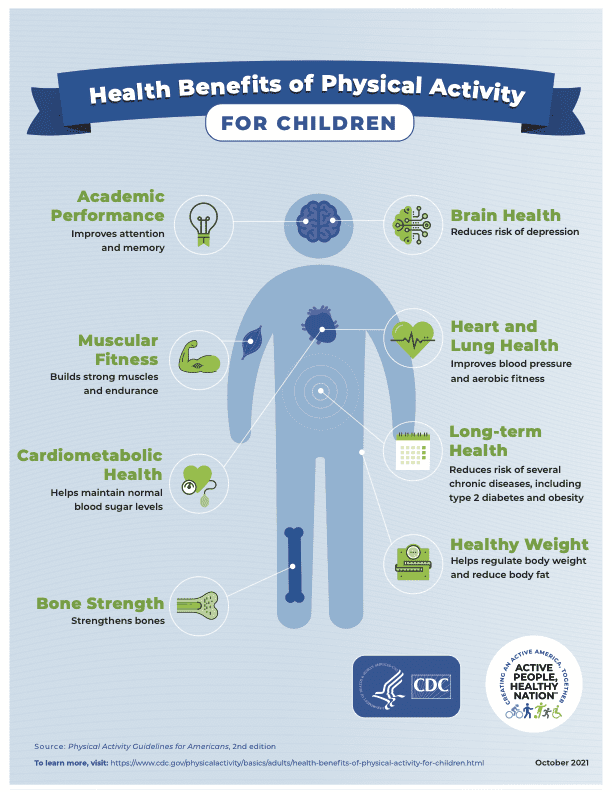What is health and wellness? And more importantly, how do these two concepts impact our lives? We set out to answer the question “what is health and wellness?” and provide actionable steps to promote a healthier United States via early intervention in physical education.
What is Health and Wellness?
The term health and wellness is used throughout society. But what is health and wellness? Although the two words are often used together or even interchangeably, they have different meanings.
Different in-depth definitions help to illustrate some of the significant distinctions:
Health is the absence of disease or infirmity. But a deeper definition outlines the state of complete physical, mental, and social well-being.
Wellness is an active process through which people become aware and make choices towards supporting overall health. Many definitions of wellness include social, emotional, intellectual, physical, spiritual, and occupational wellness.
In short, health is the goal, and wellness is the means to achieving it. From here, we can unpack the pieces of the question, “What is health and wellness?”

Unpacking The Pieces Of What Is Health and Wellness
Above, we defined health not only as the absence of disease or sickness but a deeper connection to three major components of healthy living:
Physical Health
Mental Health
Social Well Being
Within any of the three categories, we can explore what types of wellness activities and practices can help support the different aspects of our overall health.
For example, let’s explore this concept with our physical health. To avoid chronic diseases like high blood pressure, heart disease, and other common public health concerns, we need physical wellness. Therefore, regular physical activity and regular exercise can help promote overall physical health. And while this example helps illustrate one example to support physical health, it is essential to note that it takes a holistic approach, and other wellness activities can contribute to health promotion.
This same connection can be made with the different aspects of living a healthy lifestyle. Wellness in action leads to healthy living. Try this yourself with mental health or social well-being! What types of wellness can lead to mental health or social well-being?

Health By The Numbers
It is crucial to unpack the question “what is health and wellness?” because people in the United States have significant health problems. There is a disconnect between health and wellness, which has physical, mental, emotional, and financial costs.
“90% of the nation’s $4.1 trillion in annual health care expenditures are for people with chronic and mental health conditions.” – CDC.
Beyond just the financial cost associated with these health problems, the CDC has also published a list of specific health problems and data facing people in the United States. While you can find a longer list here, it is worth highlighting three that reveal a telling story of the current health condition of Americans:
Obesity: Obesity affects 20% of children and 42% of adults, putting them at risk of chronic diseases such as type 2 diabetes, heart disease, and some cancers. Over 25% of young people 17 to 24 are too heavy to join the US military. Obesity costs the US health care system nearly $173 billion a year.
Heart Disease & Stroke: Nothing kills more Americans than heart disease and stroke. More than 877,500 Americans die of heart disease or stroke every year—that’s one-third of all deaths. These diseases take an economic toll, as well, costing our health care system $216 billion per year and causing $147 billion in lost productivity on the job.
Diabetes: More than 37 million Americans have diabetes, and another 96 million adults in the United States have a condition called prediabetes, which puts them at risk for type 2 diabetes. Diabetes can cause serious complications, including heart disease, kidney failure, and blindness. In 2017, the total estimated cost of diagnosed diabetes was $327 billion in medical costs and lost productivity.

The Need For Improving Wellness
While the public health costs of unhealthy lifestyles are startling, people in the United States often still take a reactive approach. And while we should certainly provide healthcare solutions for those in need, addressing the root of our problems is vital.
Investing and encouraging wellness opportunities is the means to instill long-term healthy lifestyles. While this approach takes time and a long-term vision, wellness is the key to long-term health promotion. So, what is health and wellness in action?
Through a holistic approach, we should encourage and support people of all ages to participate in the following healthy choices. With this call to action, first, let’s explore the different elements of wellness and how they support a successful existence.
Social Wellness: Relationships, community interactions, relating to others, communication.
Emotional Wellness: Feelings, emotions, reactions, cognition, coping skills.
Intellectual Wellness: Critical thinking, creativity, curiosity, lifelong learner.
Physical Wellness: Body, nutrition, healthy habits, making healthy decisions.
Spiritual Wellness: Meaning, values, establishing peace and harmony, ability to discover purpose in life.
Occupational Wellness: Skills, finances, balance between work and leisure, satisfaction, accomplishment.
(Source: Health and Wellness Quick Reference Guide – CT.Gov)

What Is Health and Wellness For Students?
Most of this article has outlined the high-level what, why, and how of health and wellness for people. But again, people in the United States struggle to achieve many basic components of healthy behaviors and human existence. And while we still provide opportunities and resources for adults, early intervention is one of the best chances to provide long-term success.
Therefore, students throughout K-12 education should explore the question of “What is health and wellness?” And beyond the theoretical definition, students should practice and develop wellness skills that can lead to long-term healthy living.
While this can happen throughout the school day, health and physical education classes play a crucial role in developing health and wellness for students. Here, different units and topics can encourage students to participate in all aspects of wellness.
For example, middle and high school students should explore different types of physical activity in fitness centers. As a result, students will feel more comfortable and confident participating in regular physical activity once they are adults. Check out how many schools are already doing this here.
Check out more helpful links of the importance of physical education for overall health and wellness:
- Health Benefits Of Physical Education In Schools
- Physical Activity and Academic Performance
- Fitness and Mental Health
- Exercise and Self Esteem
- Managing Student Behavior With Physical Activity
- Should Physical Education Be Required?

Key Takeaways On The Future Of Health and Wellness
What is health and wellness? Again, for every individual, it may look and feel different. But at its core, basic principles can support people’s overall well-being.
Schools play a crucial role in developing health and wellness skills! Without good health, all of our other skills and knowledge are less effective as we go on to live the rest of our lives. Healthy people are happier, more productive, and more effective in life, work, and social interactions.
Our body and mind are powerful, but we must care for them! Understanding health and wellness to support and build healthy people is crucial for our country’s and people’s future. Let’s start by taking a PROACTIVE approach via schools and support health and wellness opportunities via physical education.










